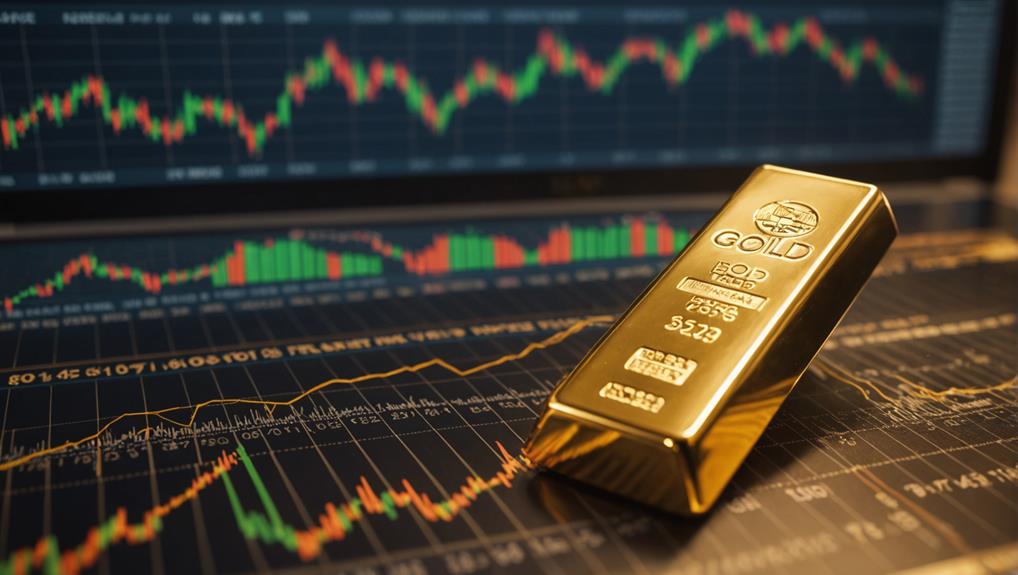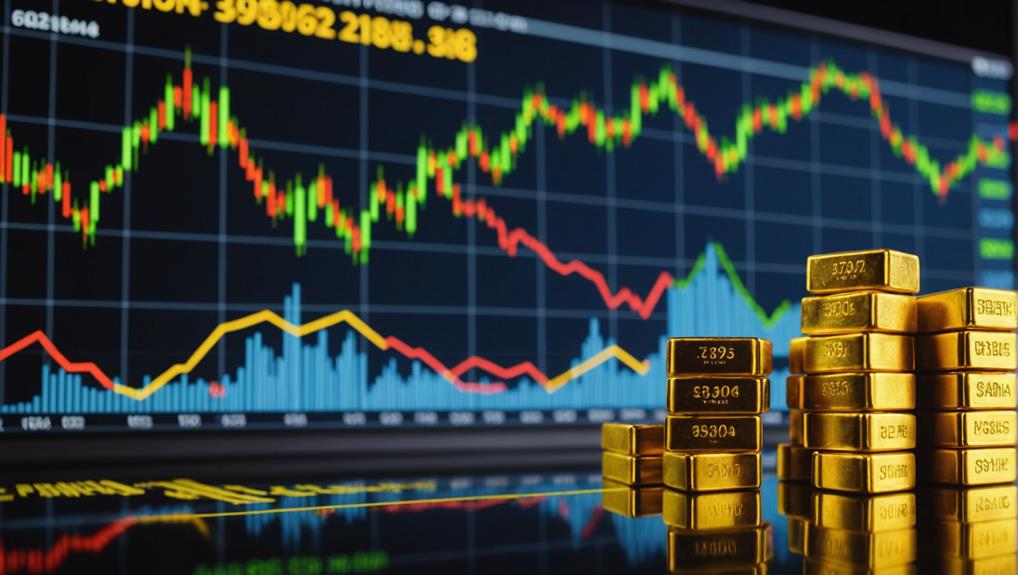Investors have long been intrigued by gold's performance during inflationary periods, as it presents a nuanced picture of fluctuating returns.
While historically gold has been viewed as a reliable hedge against inflation, recent trends in the U.S. have shown negative returns despite increasing inflation rates. This evolving dynamic prompts crucial questions about the efficacy of gold as an inflation hedge in today's economic landscape.
To navigate the risks associated with currency devaluation and asset price inflation, investors must grasp the factors influencing gold prices and its impact on portfolio diversification.
In these uncertain times, how does gold compare to other hedging options?
Key Insights
- Gold prices averaged a 14.9% increase during high inflation periods from 1974 to 2008.
- Gold's role as an inflation hedge has shown mixed results, with significant gains in some periods and declines in others.
- Recent high US inflation has resulted in negative returns for gold investments, indicating diminished effectiveness.
- Gold's value in real terms is linked to economic and money supply growth, making it a long-term inflation hedge.
- A diversified portfolio with up to 10% allocation to gold can reduce overall investment risk.
Historical Performance of Gold

Gold has a varied historical performance as an inflation hedge, showcasing exceptional returns like the 35% annual gains in the 1970s alongside significant declines, such as the 10% yearly drop from 1980 to 1984.
Investors have traditionally sought refuge in gold bullion, coins, and bars during inflationary periods. In more recent times, the availability of financial instruments like gold ETFs and gold mutual funds has made gold investments more accessible.
Despite these options, gold's performance has been inconsistent, at times lagging behind real estate, commodities, and the S&P 500. Recent data suggests sluggish growth in 2021 and 2022, indicating a changing role for gold as an inflation hedge.
Gold as an Inflation Hedge
Gold's role as an inflation hedge has shown varying results over time, yet it remains a crucial asset for investors seeking protection against currency devaluation and asset price inflation.
Historical data from 1974 to 2008 reveals that gold prices surged by an average of 14.9% during high inflation periods, highlighting its potential as a reliable inflation hedge.
Despite recent fluctuations in gold prices during inflationary periods, long-term analyses spanning over a century suggest that gold can still effectively serve this purpose.
The value of gold in real terms is intricately linked to economic and money supply growth, showcasing its intricate relationship with inflation dynamics.
This intrinsic link makes gold a valuable asset for individuals aiming to mitigate the risks associated with currency devaluation and asset price inflation.
Inflation Rates and Gold Prices

The relationship between inflation rates and gold prices has undergone significant changes over the past few decades. Historically, between 1974 and 2008, gold prices saw an average increase of 14.9% during years of high inflation. Despite the abandonment of the gold standard in 1972 and the limited correlation with the US Consumer Price Index (CPI) since the 1970s, inflation continues to have an impact on gold prices. However, this impact has diminished in recent years, partly due to subdued inflationary pressures and changes in monetary policy. Notably, the recent high inflation in the US has resulted in negative returns on gold investments. The table below outlines the key points:
| Year Range | Inflation Impact on Gold Prices |
|---|---|
| 1974-2008 | +14.9% average increase |
| Post-1970s | Weak correlation with US CPI |
| Post-1972 | Fluctuations post-gold standard |
| Recent Years | Negative returns with high inflation |
| Last Decades | Decreased sensitivity to inflation |
Gold in Portfolio Diversification
Incorporating gold into a diversified portfolio can significantly reduce overall risk by offsetting potential losses from traditional assets such as stocks and bonds, particularly during market downturns.
Experts often recommend allocating up to 10% of a portfolio to gold to capitalize on its unique performance characteristics, which typically differ from other asset classes.
Employing gold bars and coins can provide the stability and balance necessary for a more resilient investment strategy.
Gold's Diversification Benefits
Gold's reputation for having a low correlation with traditional assets makes it a valuable tool for diversifying investment portfolios. When economic uncertainty and market fluctuations arise, incorporating gold into asset allocation can enhance portfolio resilience.
Its unique characteristics allow gold to act as a stabilizing factor, offering a potential safeguard during times of volatility in other asset classes like stocks and bonds. By adding gold to their portfolios, investors can mitigate overall risk and create a more balanced investment strategy.
Even a modest allocation of up to 10% in gold can significantly strengthen a portfolio, providing protection against adverse economic conditions and improving long-term financial stability.
Optimal Portfolio Allocation
To optimize portfolio performance, diversification is key. It is often recommended that investors allocate up to 10% of their portfolio to gold as a means of enhancing variety and mitigating risk.
In times of inflation, investing in gold can be particularly beneficial due to its tendency to hold value when real interest rates are low. Gold ETFs offer a convenient avenue for including gold in a portfolio, while physical gold in the form of bars and coins serves as a tangible asset for wealth preservation.
The significant gold reserves held by central banks further emphasize the metal's stability as an asset. By integrating gold into their portfolios, investors can enhance resilience to market fluctuations and bolster overall performance, especially during periods of economic uncertainty.
Comparing Gold to Other Hedges

When assessing inflation hedges, it is essential to compare gold with other popular options such as Real Estate Investment Trusts (REITs) and Treasury Inflation-Protected Securities (TIPS).
Gold has historically served as a dependable hedge against inflation due to its close relationship with the money supply. However, its correlation with the U.S. Consumer Price Index (CPI) has diminished since the 1970s.
On the other hand, REITs, which focus on real estate investments, offer both income and potential appreciation, making them a robust inflation hedge.
TIPS, government bonds tailored to safeguard against inflation by adjusting their principal value based on CPI fluctuations, are another effective option.
Combining these assets with gold can enhance the diversification of a portfolio and effectively mitigate inflation risks.
Optimal Gold Allocation
Achieving an optimal distribution of gold within a diversified investment portfolio is crucial for managing risk and enhancing returns. Financial experts recommend allocating 2-10% of the portfolio to gold, which can include gold ETFs, to achieve effective diversification due to its historically low correlation with traditional assets.
A study conducted by the World Gold Council suggests that allocating between 2.5-9.5% to gold can enhance risk-adjusted returns, while adhering to Modern Portfolio Theory advocates for a 5-10% allocation for optimal risk reduction.
Monitoring economic indicators and inflation expectations is paramount, as they impact commodity markets and guide the ideal gold distribution strategy to mitigate portfolio volatility during times of economic uncertainty. This strategic approach equips investors with the stability needed to navigate through inflationary periods confidently.
Factors Influencing Gold Prices

Gold prices are influenced by a range of factors including economic conditions, geopolitical events, and market supply and demand dynamics. Economic downturns or political instability can drive investors toward gold as a safe haven, while market supply constraints and demand fluctuations can further impact its price.
Understanding these elements is essential for comprehending gold's behavior beyond its role as an inflation hedge.
Economic and Geopolitical Events
Gold prices are intricately linked to economic and geopolitical events, playing a crucial role in shaping investor sentiment and market dynamics.
The Federal Reserve's decisions, especially regarding interest rates, wield significant influence over the value of gold. When interest rates increase, gold loses its appeal as it does not provide any interest payments, whereas lower rates can spur higher gold prices.
The Consumer Price Index (CPI) acts as a key indicator of inflationary trends, prompting investors to turn to gold as a safeguard against rising prices.
Additionally, during times of global economic deceleration, the demand for gold tends to surge as it is perceived as a secure asset.
Geopolitical uncertainties further enhance gold's allure, leading strategic investors to diversify their portfolios with gold to ensure stability amidst global turmoil.
Market Supply and Demand
To effectively analyze and predict gold price movements, it is crucial to grasp the intricate interplay between market supply and demand. Gold prices are heavily influenced by various factors, including mining production levels, central bank acquisitions, and investor sentiment.
Elevated demand typically leads to price increases, particularly during times of economic uncertainty when gold is sought after as a safe-haven asset. The volatility in the market, driven by quantitative easing measures and the performance of inflation-linked bonds, further amplifies the fluctuations in commodity prices.
Geopolitical developments and economic indicators also exert significant influences on both the supply and demand sides of the market. As central banks adapt their policies and investors respond to changing economic conditions, these factors collectively mold the market environment, underscoring the importance of comprehending the intricate relationship between supply and demand in shaping gold prices.
Conclusion
Gold's relationship with inflation is intricate, displaying periods of high returns and significant losses. Despite recent underperformance during times of high inflation, gold remains a vital component in diversified portfolios, offering stability and safeguarding against currency devaluation and asset price inflation.
Understanding the historical performance, ideal allocation, and factors influencing gold prices can aid investors in utilizing gold as a reliable hedge against inflation-related risks.
For additional information on gold, please reach out to:
The Gold Information Network
11900 Biscayne Blvd, Ste 127B, Miami, FL 33181
(305) 449-9094
https://goldinfo.net







